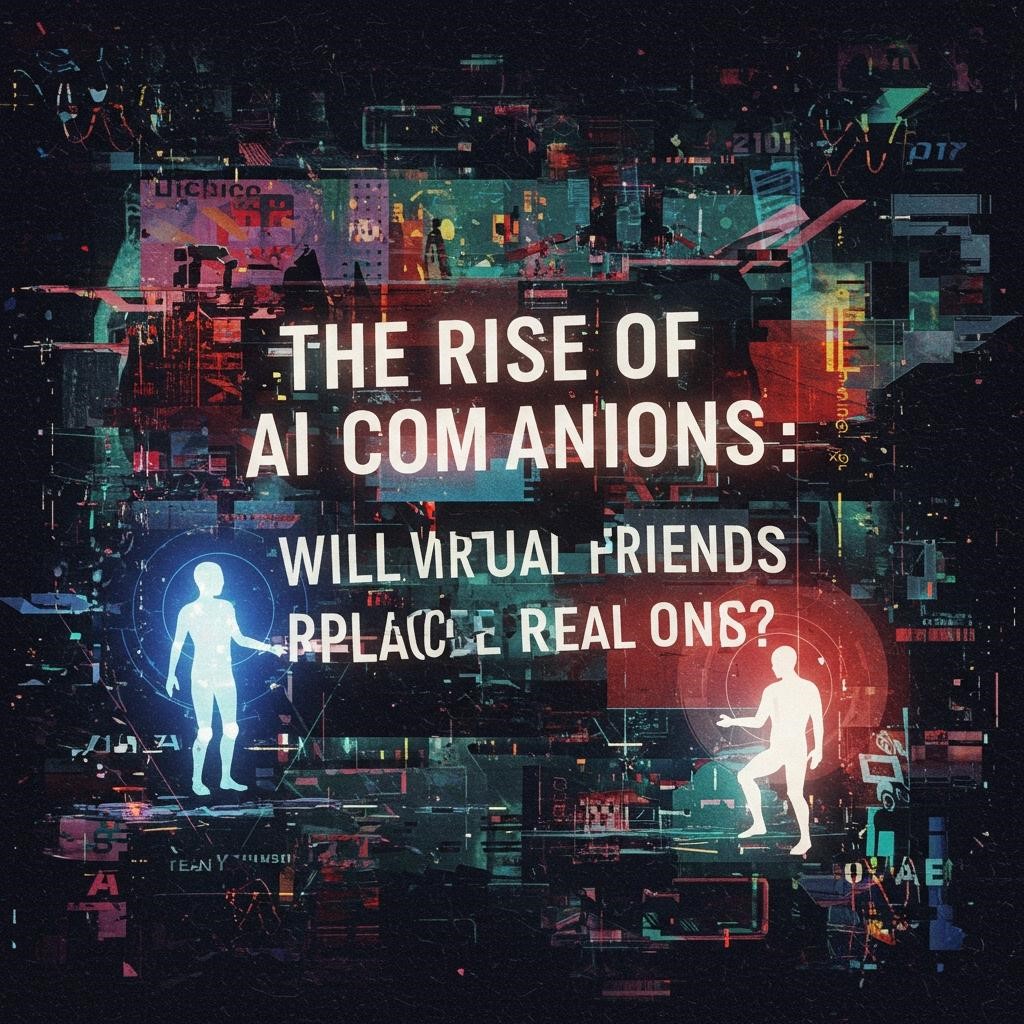By Swayam Nerkar
Introduction
In the digital era, artificial intelligence (AI) has permeated nearly every aspect of our daily lives, from the way we shop and work to how we communicate and seek entertainment. One of the most fascinating, and perhaps controversial, developments in AI technology is the emergence of AI companions—virtual entities designed to interact with humans in ways that mimic real friendship.
The notion of forging meaningful relationships with digital beings raises profound questions about the future of social connection. With AI companions growing ever more sophisticated, society is left to ponder: Will virtual friends replace real ones, or are they simply a supplement to human connection?
This article explores the evolution of AI companions, their appeal, the social and psychological impact they are having, and whether they can truly replace the unique qualities of real human friendships.
The Evolution of AI Companions
From Simple Programs to Lifelike Interactions
AI companions did not emerge overnight. Their history can be traced back to basic computer programs designed to simulate conversation, such as the famous ELIZA program developed at MIT in the 1960s. ELIZA’s simple script-based responses gave users the illusion of interacting with a human therapist, though it was limited and easily exposed as non-human.
Fast forward to the present day, and AI companions are powered by sophisticated neural networks, natural language processing, and machine learning algorithms. Modern AI entities like Replika, Xiaoice, and ChatGPT can hold engaging conversations, remember details about users, offer encouragement, and even exhibit a sense of humor. Some incorporate voice synthesis and visual avatars, making interactions more immersive. These advancements have transformed AI companions from mere novelties into digital presences that can, for some, feel genuinely supportive and emotionally resonant.
Integration into Daily Life
AI companions are now available across multiple platforms—smartphones, computers, gaming consoles, and even smart speakers. Some are marketed for mental health support, acting as always-available listeners who can help users process emotions or practice social skills. Others are designed for entertainment or productivity, providing reminders, telling jokes, or role-playing as characters in interactive stories.
The integration of AI companions into everyday life is also being accelerated by the rapid adoption of virtual reality (VR) and augmented reality (AR) technologies. These platforms promise to make virtual friends even more lifelike, offering the possibility of shared experiences in digital environments.
Why Are People Turning to Virtual Friends?
Addressing Loneliness and Social Anxiety
Loneliness is increasingly recognized as a major public health concern, with studies linking it to higher risks of depression, anxiety, and even physical health problems. The COVID-19 pandemic, with its lockdowns and social distancing measures, only exacerbated feelings of isolation for millions around the world.
AI companions offer a form of connection that is accessible, judgment-free, and always available. For individuals who struggle with social anxiety, have limited social circles, or are separated from friends and family, these virtual friends can provide much-needed comfort and interaction.
A Safe Space for Self-Expression
Unlike human friends, AI companions do not judge, gossip, or hold grudges. This creates a safe space for users to express thoughts and feelings they might otherwise keep private. Users can share secrets, vent frustrations, or explore aspects of their personality without fear of negative consequences. This can be particularly beneficial for teens and young adults navigating complex social environments, or for people dealing with stigmatized issues.
Customization and Control
AI companions can be tailored to suit individual preferences. Users can choose the personality, appearance, and conversational style of their virtual friends. Some platforms allow users to script responses or set parameters for the types of interactions they want to have. This level of customization is rarely possible in human relationships, where personalities and behaviors are less predictable.
24/7 Availability
Unlike real friends, who have their own lives and schedules, AI companions are always “on.” Whether it’s late at night or during a quiet moment in the day, users can initiate a conversation and receive immediate engagement. For people who work irregular hours or live in different time zones from their social circles, this constant availability is a major draw.
The Psychological and Social Impact
Emotional Attachment to AI
Research has shown that humans are capable of forming emotional bonds with non-human entities, from pets to inanimate objects. With AI companions, the lines between real and artificial relationships can become blurred. Users often report feeling genuine affection for their virtual friends, experiencing comfort, motivation, and even grief if an AI service is discontinued.
However, this emotional attachment can be a double-edged sword. Some psychologists warn that over-reliance on AI companions may hinder the development of real-world social skills or exacerbate existing mental health challenges. The illusion of intimacy provided by AI, though comforting, cannot replace the complexity and unpredictability of human relationships.
AI as a Tool for Social Good
On the other hand, AI companions have shown potential as tools for social good. In therapeutic settings, AI chatbots can provide immediate support to people experiencing distress or suicidal thoughts, acting as a first line of defense before human intervention is available. For elderly individuals living alone, AI companions can help combat loneliness and encourage cognitive engagement.
Additionally, AI companions can serve as social bridges for neurodiverse individuals or those with disabilities, offering a non-threatening environment to practice conversation and social cues.
Ethical Considerations
The rise of AI companions also raises important ethical questions. Issues of privacy, data security, and consent are paramount, as these companions often require access to personal information to provide personalized interactions. There are concerns about the potential for manipulation, especially if AI companions are used to promote products or services to vulnerable users.
Moreover, the question of whether AI should simulate emotions or form attachments is hotly debated. Some ethicists argue that creating AI entities that mimic friendship or love could mislead users or foster unhealthy dependencies.
Can AI Companions Replace Human Relationships?
The Unique Qualities of Human Friendship
Human friendships are built on shared experiences, mutual understanding, and emotional reciprocity. They involve complex, dynamic interactions that evolve over time, shaped by context, culture, and personality. Real friends offer more than just conversation—they provide support in times of need, celebrate achievements, and share in the joys and sorrows of life.
While AI companions can simulate many aspects of friendship—listening, remembering, responding—they lack the ability to truly empathize or share lived experiences. Their understanding is based on algorithms and data rather than genuine emotion or consciousness. As a result, the depth and authenticity of human relationships remain unmatched.
The Limits of AI
AI companions, for all their sophistication, are still limited by the data and programming that underpin them. They cannot experience the world, form memories in the human sense, or act independently of their code. While they can provide comfort and companionship, they cannot replace the spontaneous, messy, and unpredictable nature of real human connections.
Furthermore, the knowledge that an AI companion is not truly sentient can create a barrier to full emotional investment. Users may enjoy the illusion of friendship but ultimately recognize its limitations.
The Hybrid Future: AI as Supplement, Not Substitute
Rather than replacing real friends, it is more likely that AI companions will serve as a supplement to human relationships. They can help fill gaps in social interaction, provide support during periods of loneliness, or assist in developing social skills. In some cases, they may even act as catalysts, encouraging users to reach out to real-world friends or participate in social activities.
The most meaningful friendships will continue to be those formed with other humans, enriched by shared history, mutual understanding, and the capacity for growth and change.
The Role of AI Companions in Different Age Groups
Children and Teens
For children and teenagers, AI companions can be both beneficial and risky. On the positive side, they can provide a safe environment to practice communication skills, explore interests, and receive support during formative years. AI companions can also serve as educational tools, offering tutoring or language practice.
However, concerns exist about the potential for over-reliance on virtual friends at the expense of real-world social development. Parents and educators must ensure that AI companions are used as a supplement to, not a replacement for, interaction with peers and family.
Adults
Adults may turn to AI companions for a variety of reasons—stress relief, companionship during life transitions, or simply for entertainment. For those living in new cities, working remotely, or managing busy schedules, AI friends can offer a sense of connection and continuity.
At the same time, adults are generally more aware of the boundaries between AI and real relationships, using virtual companions as tools rather than substitutes.
The Elderly
For older adults, especially those living alone or in care facilities, AI companions can provide significant benefits. They can offer conversation, reminders for medication, and even monitor for signs of distress. In some cases, AI companions have been shown to reduce feelings of loneliness and improve mental health.
However, it is important to ensure that AI companions do not replace human caregivers or family visits, which are essential for emotional well-being.
The Future of Friendship: Technological and Social Trends
Advances in AI Technology
AI companions are poised to become even more advanced in the coming years. Developments in emotional intelligence, speech recognition, and personalization will make interactions with virtual friends increasingly indistinguishable from those with humans. The integration of AI with virtual reality and augmented reality will further enhance the sense of presence and shared experience.
Societal Shifts
As society becomes more comfortable with digital relationships, the stigma associated with having virtual friends may diminish. AI companions could play a larger role in education, healthcare, and entertainment, becoming accepted parts of everyday life.
However, it will be crucial to maintain a balance, ensuring that technology enhances rather than replaces genuine human connection.
Regulation and Safeguards
To ensure the ethical use of AI companions, policymakers and developers must establish guidelines around privacy, data security, and emotional well-being. Transparency about the capabilities and limitations of AI entities is essential, as is the provision of resources for users who may develop unhealthy attachments.
Conclusion
The rise of AI companions represents a remarkable intersection of technology and human psychology, offering new ways to connect and find support in an increasingly digital world. While virtual friends can provide comfort, companionship, and even therapeutic benefits, they are unlikely to replace the irreplaceable—real human relationships.
The future of friendship may lie in a hybrid model, where AI companions support and enhance our social lives without substituting the warmth, complexity, and authenticity of connections with other people. As we continue to explore the possibilities of AI, it is up to us to ensure that technology serves to enrich, rather than diminish, our shared humanity.







